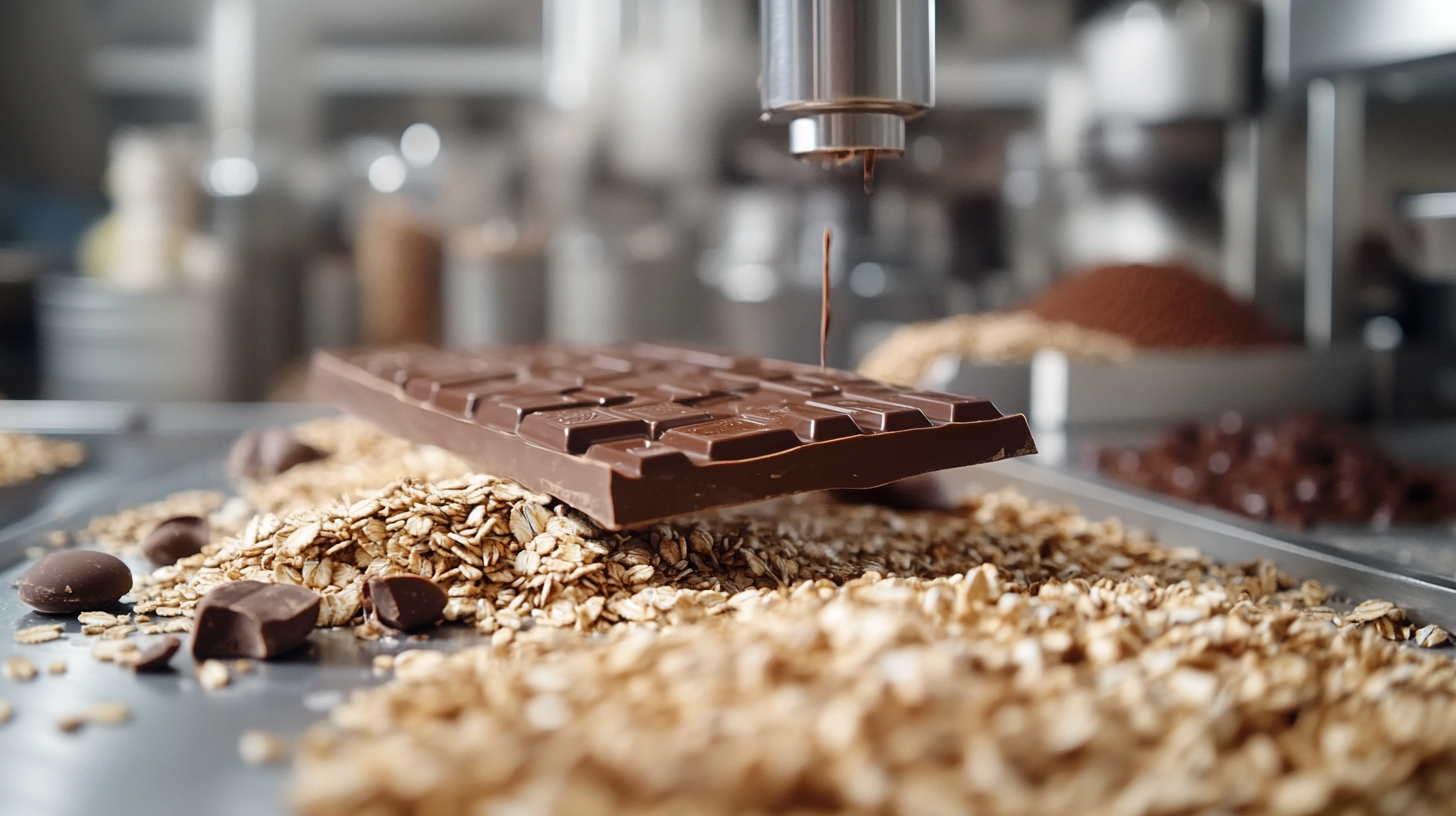How to Optimize Production Efficiency with Oatmeal Chocolate Moulding Machines
The global chocolate market is on a remarkable growth trajectory, projected to reach a valuation of USD 161.56 billion by 2027, driven by rising consumer demand for innovative and high-quality chocolate products. Among these innovations, oatmeal chocolate moulding machines have emerged as a vital technological advancement that caters to both the artisanal and industrial segments of the market. These machines not only enhance the efficiency of the production process but also enable manufacturers to explore new flavors and textures, thereby attracting a broader audience.
Incorporating oatmeal into chocolate products is gaining popularity due to its inherent health benefits and unique taste profile. Research indicates that approximately 48% of consumers are now seeking snack options that offer nutritional value without compromising on taste. Therefore, optimizing production efficiency with oatmeal chocolate moulding machines can significantly impact a company's bottom line while meeting the evolving preferences of health-conscious consumers. This blog will explore effective strategies for maximizing the capabilities of these machines, ultimately paving the way for increased profitability and customer satisfaction in the competitive chocolate landscape.

Understanding the Basics of Oatmeal Chocolate Moulding Machines
Oatmeal chocolate moulding machines are revolutionizing the production processes in the confectionery industry. Understanding the basics of these machines is essential for optimizing production efficiency. These machines primarily function by utilizing templates to mold chocolate into various shapes, with oatmeal being a key ingredient enhancing both texture and flavor. The efficient operation of these machines can significantly reduce waste, streamline ingredient usage, and improve the overall production throughput. Research indicates that implementing advanced oatmeal chocolate moulding technology can increase production rates by up to 30% when compared to traditional methods. The machines are designed to minimize temperature variations, ensuring consistent quality in the chocolate molding process. Furthermore, the use of precise control systems allows for the seamless integration of ingredients, which can lead to a more uniform product and reduce the likelihood of product defects. In addition, the significance of machine vision technology in these systems cannot be understated. By incorporating machine vision, manufacturers can conduct real-time quality inspections that help maintain high standards throughout the production line. This not only contributes to improved product quality but also reduces the number of returns or recalls, contributing to a more sustainable and cost-effective production cycle. Overall, a thorough understanding of oatmeal chocolate moulding machines and the technologies that enhance their functionality is essential for companies aiming to boost their production efficiency while maintaining product excellence. With the right investment in these machines, businesses can expect to see a substantial return, ensuring they stay competitive in the ever-evolving market of confectionery goods.

Key Features to Look for in Oatmeal Chocolate Moulding Equipment
When considering the optimization of production efficiency in the chocolate industry, especially with oatmeal chocolate moulding machines, it's essential to focus on several key features that enhance performance. The ability of equipment to maintain a consistent temperature and humidity level during the moulding process is critical. According to the National Confectioners Association, maintaining optimal conditions can reduce waste by up to 15%, ensuring that every batch produced meets quality standards.
Another important feature to consider is the speed and precision of the moulding machines. Modern equipment should be able to mold large quantities of chocolate without compromising quality or detail. Data from the International Cocoa Organization indicates that producers who invest in high-speed moulding machines can increase their output by as much as 25% while also ensuring uniformity in shape and size, which is crucial for consumer appeal.
Furthermore, flexibility is a valuable asset in oatmeal chocolate moulding equipment. Machines that can easily switch between different product types—like chocolate bars, shapes, or fillings without extensive downtime—are essential for meeting dynamic consumer demands. A report by Research and Markets reveals that manufacturers who adopt versatile machinery can respond more effectively to market trends, potentially increasing their market share by 10% annually. As the confectionery industry continues to evolve, focusing on these key features will significantly enhance production efficiency and product quality.

Strategies to Streamline Production Processes for Maximum Efficiency
In the pursuit of maximizing production efficiency, particularly with oatmeal chocolate moulding machines, businesses can harness several strategies to streamline their processes. One effective approach lies in the integration of artificial intelligence and machine learning technologies. By deploying AI in manufacturing environments, companies can enhance operational speed, improve product quality, and minimize waste. Smart robots and data-driven analysis not only automate repetitive tasks but also predict maintenance needs, preventing costly breakdowns that can disrupt production lines.
Additionally, leveraging AI-based demand forecasting can significantly enhance prediction accuracy, enabling manufacturers to align production with actual market needs. This adaptive approach reduces excess inventory and ensures that resources are allocated wisely, optimizing the workflow from raw material procurement to final product delivery. Companies can also benefit from the latest bioprocess strategies to improve the performance of bioreactors, which are essential for modern production methods. By adopting these advanced techniques, businesses can achieve comprehensive improvements in both quality and efficiency.
Ultimately, embracing technology—be it through smart machinery, AI applications, or innovative bioprocesses—will empower manufacturers to not only streamline their production workflows but also to adapt to the evolving demands of today’s markets. By focusing on these strategies, companies will be well-positioned to maximize output and maintain a competitive edge in the rapidly changing landscape of the manufacturing industry.

Maintenance Tips to Enhance the Longevity of Moulding Machines
Maintaining the efficiency of oatmeal chocolate moulding machines is essential for ensuring consistent production quality. Regular maintenance not only enhances the longevity of these machines but also minimizes unexpected breakdowns that can disrupt production schedules. Similar to household appliances like washing machines, moulding machines require specific attention to keep them operating optimally.
One crucial maintenance tip is to conduct regular inspections of all mechanical components. Checking the belts, bearings, and pulleys can help identify wear and tear before they lead to larger issues. Additionally, just as washing machines benefit from periodic cleaning to prevent mold and buildup, moulding machines should be cleaned thoroughly at regular intervals. This involves removing any residual chocolate or oatmeal deposits, which can lead to performance issues if left unattended.
Another effective maintenance strategy involves reducing moisture exposure around the machinery. While some might think open ventilation helps, keeping areas around the machines dry is essential for preventing corrosion and operational inefficiencies. This is akin to washing machine care, where managing moisture levels prevents mold growth inside the appliance. By following these maintenance tips, operators can ensure their oatmeal chocolate moulding machines remain in top condition, ultimately enhancing production efficiency and reducing costs over the long term.
The Role of Automation in Oatmeal Chocolate Production Optimization
In the ever-evolving landscape of food production, automation plays a pivotal role in optimizing the efficiency of oatmeal chocolate production. The integration of oatmeal chocolate moulding machines not only enhances the speed of production but also ensures consistent quality. According to a recent report by The Food Processing Industry Association, automated production lines can increase output by up to 30%, drastically reducing the time taken from ingredient mixing to final product packaging.
Automation in oatmeal chocolate production also minimizes human error, a critical factor in maintaining high standards of quality. With the implementation of precision machinery, manufacturers can achieve uniformity in texture and flavor, which is crucial for brand consistency. A study from the International Journal of Food Science and Technology highlighted that factories employing advanced automation reported a 20% reduction in defective products, underscoring the role of technology in quality control.
Moreover, the operational cost savings associated with automation cannot be overlooked. The same report from The Food Processing Industry Association noted that manufacturers adopting automated processes save approximately 15% on labor costs. This reduction in expenditure allows companies to reinvest in research and development, focusing on new product innovations in the competitive oatmeal chocolate market. By leveraging technology, businesses are not only optimizing their production efficiency but also future-proofing their operations in an increasingly digital world.
